蛋白质纯化的原理和方法
- 格式:doc
- 大小:658.50 KB
- 文档页数:13
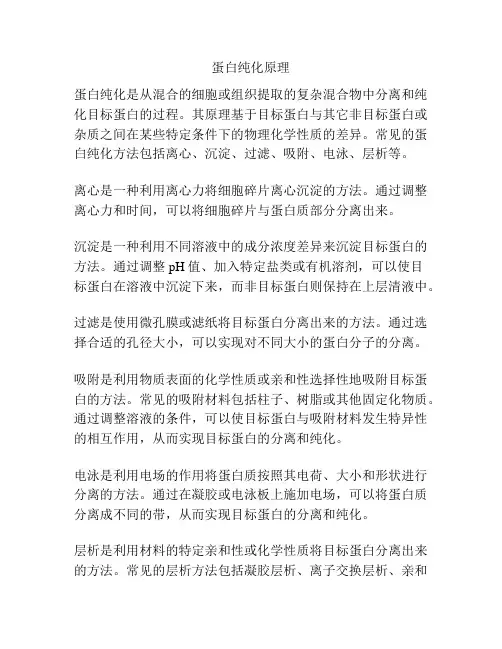
蛋白纯化原理
蛋白纯化是从混合的细胞或组织提取的复杂混合物中分离和纯化目标蛋白的过程。
其原理基于目标蛋白与其它非目标蛋白或杂质之间在某些特定条件下的物理化学性质的差异。
常见的蛋白纯化方法包括离心、沉淀、过滤、吸附、电泳、层析等。
离心是一种利用离心力将细胞碎片离心沉淀的方法。
通过调整离心力和时间,可以将细胞碎片与蛋白质部分分离出来。
沉淀是一种利用不同溶液中的成分浓度差异来沉淀目标蛋白的方法。
通过调整pH值、加入特定盐类或有机溶剂,可以使目
标蛋白在溶液中沉淀下来,而非目标蛋白则保持在上层清液中。
过滤是使用微孔膜或滤纸将目标蛋白分离出来的方法。
通过选择合适的孔径大小,可以实现对不同大小的蛋白分子的分离。
吸附是利用物质表面的化学性质或亲和性选择性地吸附目标蛋白的方法。
常见的吸附材料包括柱子、树脂或其他固定化物质。
通过调整溶液的条件,可以使目标蛋白与吸附材料发生特异性的相互作用,从而实现目标蛋白的分离和纯化。
电泳是利用电场的作用将蛋白质按照其电荷、大小和形状进行分离的方法。
通过在凝胶或电泳板上施加电场,可以将蛋白质分离成不同的带,从而实现目标蛋白的分离和纯化。
层析是利用材料的特定亲和性或化学性质将目标蛋白分离出来的方法。
常见的层析方法包括凝胶层析、离子交换层析、亲和
层析等。
通过选择合适的层析材料和溶液条件,可以实现目标蛋白与其他成分的分离。
综合应用以上方法,根据目标蛋白的特性和需求,可以选择合适的纯化方法或组合方法,以达到高纯度和高活性的目标蛋白。
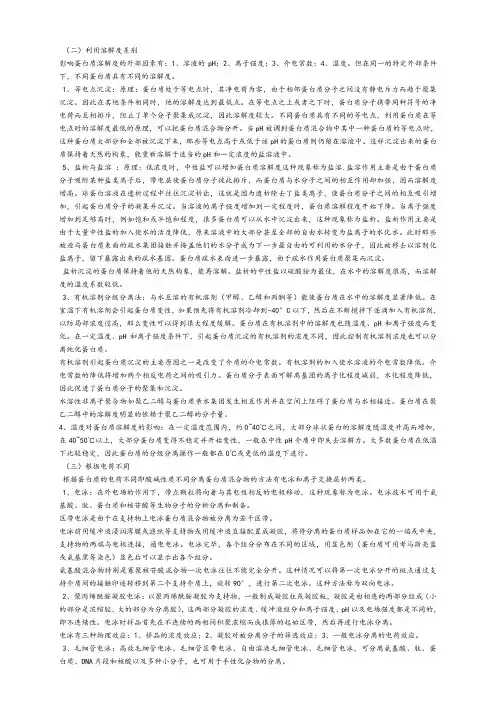
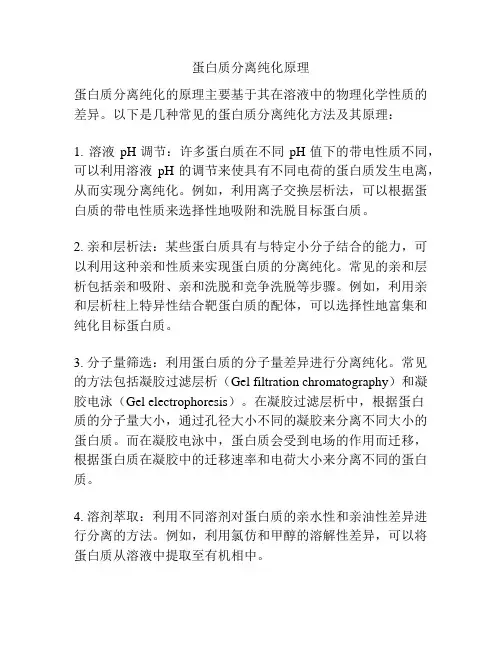
蛋白质分离纯化原理
蛋白质分离纯化的原理主要基于其在溶液中的物理化学性质的差异。
以下是几种常见的蛋白质分离纯化方法及其原理:
1. 溶液pH调节:许多蛋白质在不同pH值下的带电性质不同,可以利用溶液pH的调节来使具有不同电荷的蛋白质发生电离,从而实现分离纯化。
例如,利用离子交换层析法,可以根据蛋白质的带电性质来选择性地吸附和洗脱目标蛋白质。
2. 亲和层析法:某些蛋白质具有与特定小分子结合的能力,可以利用这种亲和性质来实现蛋白质的分离纯化。
常见的亲和层析包括亲和吸附、亲和洗脱和竞争洗脱等步骤。
例如,利用亲和层析柱上特异性结合靶蛋白质的配体,可以选择性地富集和纯化目标蛋白质。
3. 分子量筛选:利用蛋白质的分子量差异进行分离纯化。
常见的方法包括凝胶过滤层析(Gel filtration chromatography)和凝胶电泳(Gel electrophoresis)。
在凝胶过滤层析中,根据蛋白
质的分子量大小,通过孔径大小不同的凝胶来分离不同大小的蛋白质。
而在凝胶电泳中,蛋白质会受到电场的作用而迁移,根据蛋白质在凝胶中的迁移速率和电荷大小来分离不同的蛋白质。
4. 溶剂萃取:利用不同溶剂对蛋白质的亲水性和亲油性差异进行分离的方法。
例如,利用氯仿和甲醇的溶解性差异,可以将蛋白质从溶液中提取至有机相中。
5. 冷沉淀:利用低温和高盐浓度的方法使蛋白质从溶液中沉淀出来。
具有固定温度和浓度阈值的蛋白质会在特定条件下沉淀而分离纯化。
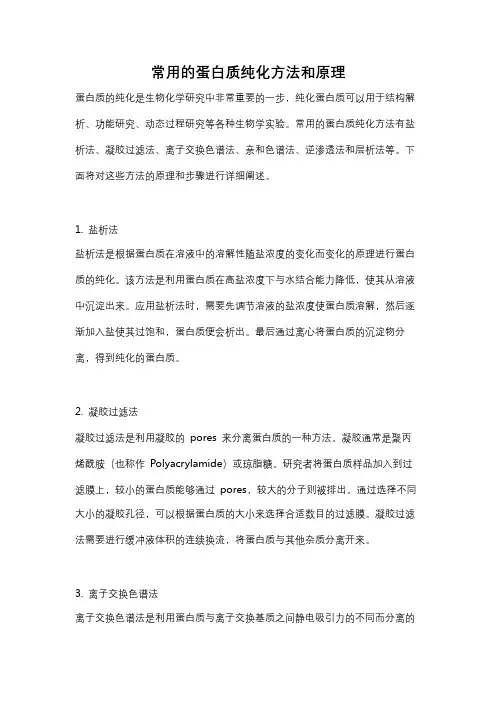
常用的蛋白质纯化方法和原理蛋白质的纯化是生物化学研究中非常重要的一步,纯化蛋白质可以用于结构解析、功能研究、动态过程研究等各种生物学实验。
常用的蛋白质纯化方法有盐析法、凝胶过滤法、离子交换色谱法、亲和色谱法、逆渗透法和层析法等。
下面将对这些方法的原理和步骤进行详细阐述。
1. 盐析法盐析法是根据蛋白质在溶液中的溶解性随盐浓度的变化而变化的原理进行蛋白质的纯化。
该方法是利用蛋白质在高盐浓度下与水结合能力降低,使其从溶液中沉淀出来。
应用盐析法时,需要先调节溶液的盐浓度使蛋白质溶解,然后逐渐加入盐使其过饱和,蛋白质便会析出。
最后通过离心将蛋白质的沉淀物分离,得到纯化的蛋白质。
2. 凝胶过滤法凝胶过滤法是利用凝胶的pores 来分离蛋白质的一种方法。
凝胶通常是聚丙烯酰胺(也称作Polyacrylamide)或琼脂糖。
研究者将蛋白质样品加入到过滤膜上,较小的蛋白质能够通过pores,较大的分子则被排出。
通过选择不同大小的凝胶孔径,可以根据蛋白质的大小来选择合适数目的过滤膜。
凝胶过滤法需要进行缓冲液体积的连续换流,将蛋白质与其他杂质分离开来。
3. 离子交换色谱法离子交换色谱法是利用蛋白质与离子交换基质之间静电吸引力的不同而分离的方法。
离子交换基质通常是富含正离子或负离子的高分子材料。
在离子交换色谱法中,样品溶液在特定的pH 下流经离子交换基质,带有不同电荷的蛋白质能够与基质发生反应,吸附在基质上。
为了获得纯化蛋白质,需要通过梯度洗脱,逐渐改变缓冲液pH 或离子浓度,使吸附在离子交换基质上的蛋白质逐渐释放出来。
4. 亲和色谱法亲和色谱法是利用蛋白质与特定的配体相互作用特异性进行分离的方法。
配体可以是天然物质,如金属离子、辅酶或抗体,也可以是人工合成的结构。
在亲和色谱法中,样品溶液经过含有配体的固定相,与配体发生特异性相互作用,蛋白质与其它组分分离。
然后可以通过改变某些条件(如pH、温度或离子浓度)来洗脱纯化的蛋白质。

蛋白质的纯化原理一)根据蛋白质溶解度不同的分离方法1、蛋白质的盐析中性盐对蛋白质的溶解度有显著影响,一般在低盐浓度下随着盐浓度升高,蛋白质的溶解度增加,此称盐溶;当盐浓度继续升高时,蛋白质的溶解度不同程度下降并先后析出,这种现象称盐析,将大量盐加到蛋白质溶液中,高浓度的盐离子(如硫酸铵的SO4和NH4)有很强的水化力,可夺取蛋白质分子的水化层,使之“失水”,于是蛋白质胶粒凝结并沉淀析出。
盐析时若溶液pH在蛋白质等电点则效果更好。
由于各种蛋白质分子颗粒大小、亲水程度不同,故盐析所需的盐浓度也不一样,因此调节混合蛋白质溶液中的中性盐浓度可使各种蛋白质分段沉淀。
影响盐析的因素有:(1)温度:除对温度敏感的蛋白质在低温(4度)操作外,一般可在室温中进行。
一般温度低蛋白质溶介度降低。
但有的蛋白质(如血红蛋白、肌红蛋白、清蛋白)在较高的温度(25度)比0度时溶解度低,更容易盐析。
(2)pH值:大多数蛋白质在等电点时在浓盐溶液中的溶介度最低。
(3)蛋白质浓度:蛋白质浓度高时,欲分离的蛋白质常常夹杂着其他蛋白质地一起沉淀出来(共沉现象)。
因此在盐析前血清要加等量生理盐水稀释,使蛋白质含量在2.5-3.0%。
蛋白质盐析常用的中性盐,主要有硫酸铵、硫酸镁、硫酸钠、氯化钠、磷酸钠等。
其中应用最多的硫酸铵,它的优点是温度系数小而溶解度大(25度时饱和溶液为4.1M,即767克/升;0度时饱和溶解度为3.9M,即676克/升),在这一溶解度范围内,许多蛋白质和酶都可以盐析出来;另外硫酸铵分段盐析效果也比其他盐好,不易引起蛋白质变性。
硫酸铵溶液的pH常在4.5-5.5之间,当用其他pH值进行盐析时,需用硫酸或氨水调节。
蛋白质在用盐析沉淀分离后,需要将蛋白质中的盐除去,常用的办法是透析,即把蛋白质溶液装入秀析袋内(常用的是玻璃纸),用缓冲液进行透析,并不断的更换缓冲液,因透析所需时间较长,所以最好在低温中进行。
此外也可用葡萄糖凝胶G-25或G-50过柱的办法除盐,所用的时间就比较短。
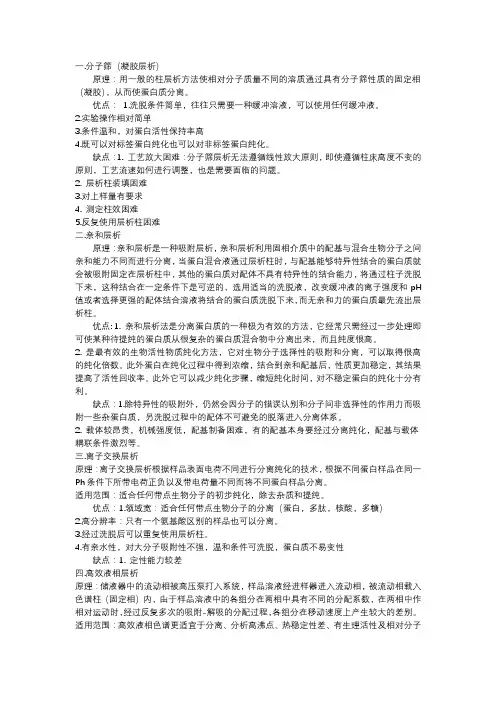
一.分子筛(凝胶层析)原理:用一般的柱层析方法使相对分子质量不同的溶质通过具有分子筛性质的固定相(凝胶),从而使蛋白质分离。
优点:1.洗脱条件简单,往往只需要一种缓冲溶液,可以使用任何缓冲液。
2.实验操作相对简单3.条件温和,对蛋白活性保持率高4.既可以对标签蛋白纯化也可以对非标签蛋白纯化。
缺点:1. 工艺放大困难:分子筛层析无法遵循线性放大原则,即使遵循柱床高度不变的原则,工艺流速如何进行调整,也是需要面临的问题。
2. 层析柱装填困难3.对上样量有要求4.测定柱效困难5.反复使用层析柱困难二.亲和层析原理:亲和层析是一种吸附层析,亲和层析利用固相介质中的配基与混合生物分子之间亲和能力不同而进行分离,当蛋白混合液通过层析柱时,与配基能够特异性结合的蛋白质就会被吸附固定在层析柱中,其他的蛋白质对配体不具有特异性的结合能力,将通过柱子洗脱下来,这种结合在一定条件下是可逆的,选用适当的洗脱液,改变缓冲液的离子强度和pH 值或者选择更强的配体结合溶液将结合的蛋白质洗脱下来,而无亲和力的蛋白质最先流出层析柱。
优点:1. 亲和层析法是分离蛋白质的一种极为有效的方法,它经常只需经过一步处理即可使某种待提纯的蛋白质从很复杂的蛋白质混合物中分离出来,而且纯度很高。
2. 是最有效的生物活性物质纯化方法,它对生物分子选择性的吸附和分离,可以取得很高的纯化倍数。
此外蛋白在纯化过程中得到浓缩,结合到亲和配基后,性质更加稳定,其结果提高了活性回收率。
此外它可以减少纯化步骤,缩短纯化时间,对不稳定蛋白的纯化十分有利。
缺点:1.除特异性的吸附外,仍然会因分子的错误认别和分子间非选择性的作用力而吸附一些杂蛋白质,另洗脱过程中的配体不可避免的脱落进入分离体系。
2. 载体较昂贵,机械强度低,配基制备困难,有的配基本身要经过分离纯化,配基与载体耦联条件激烈等。
三.离子交换层析原理:离子交换层析根据样品表面电荷不同进行分离纯化的技术,根据不同蛋白样品在同一Ph条件下所带电荷正负以及带电荷量不同而将不同蛋白样品分离。
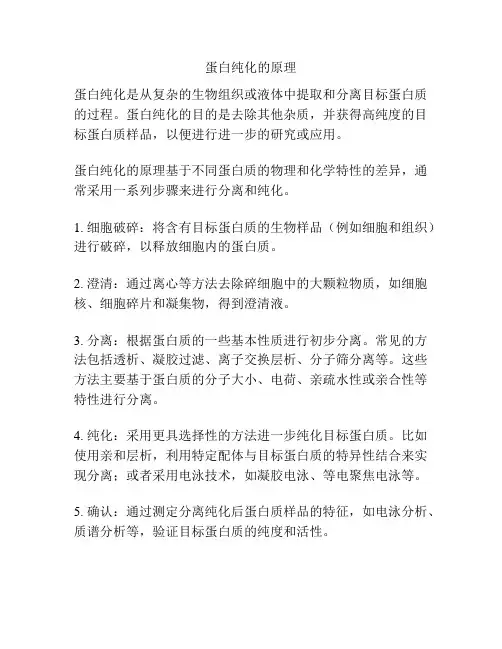
蛋白纯化的原理
蛋白纯化是从复杂的生物组织或液体中提取和分离目标蛋白质的过程。
蛋白纯化的目的是去除其他杂质,并获得高纯度的目标蛋白质样品,以便进行进一步的研究或应用。
蛋白纯化的原理基于不同蛋白质的物理和化学特性的差异,通常采用一系列步骤来进行分离和纯化。
1. 细胞破碎:将含有目标蛋白质的生物样品(例如细胞和组织)进行破碎,以释放细胞内的蛋白质。
2. 澄清:通过离心等方法去除碎细胞中的大颗粒物质,如细胞核、细胞碎片和凝集物,得到澄清液。
3. 分离:根据蛋白质的一些基本性质进行初步分离。
常见的方法包括透析、凝胶过滤、离子交换层析、分子筛分离等。
这些方法主要基于蛋白质的分子大小、电荷、亲疏水性或亲合性等特性进行分离。
4. 纯化:采用更具选择性的方法进一步纯化目标蛋白质。
比如使用亲和层析,利用特定配体与目标蛋白质的特异性结合来实现分离;或者采用电泳技术,如凝胶电泳、等电聚焦电泳等。
5. 确认:通过测定分离纯化后蛋白质样品的特征,如电泳分析、质谱分析等,验证目标蛋白质的纯度和活性。
不同的蛋白纯化方法可以根据目标蛋白质的特性和需求进行组合和优化,以达到高效、快速和高纯度的纯化效果。
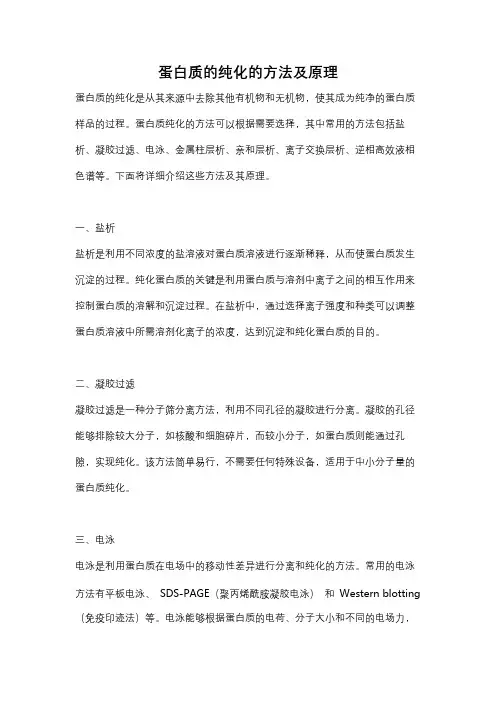
蛋白质的纯化的方法及原理蛋白质的纯化是从其来源中去除其他有机物和无机物,使其成为纯净的蛋白质样品的过程。
蛋白质纯化的方法可以根据需要选择,其中常用的方法包括盐析、凝胶过滤、电泳、金属柱层析、亲和层析、离子交换层析、逆相高效液相色谱等。
下面将详细介绍这些方法及其原理。
一、盐析盐析是利用不同浓度的盐溶液对蛋白质溶液进行逐渐稀释,从而使蛋白质发生沉淀的过程。
纯化蛋白质的关键是利用蛋白质与溶剂中离子之间的相互作用来控制蛋白质的溶解和沉淀过程。
在盐析中,通过选择离子强度和种类可以调整蛋白质溶液中所需溶剂化离子的浓度,达到沉淀和纯化蛋白质的目的。
二、凝胶过滤凝胶过滤是一种分子筛分离方法,利用不同孔径的凝胶进行分离。
凝胶的孔径能够排除较大分子,如核酸和细胞碎片,而较小分子,如蛋白质则能通过孔隙,实现纯化。
该方法简单易行,不需要任何特殊设备,适用于中小分子量的蛋白质纯化。
三、电泳电泳是利用蛋白质在电场中的移动性差异进行分离和纯化的方法。
常用的电泳方法有平板电泳、SDS-PAGE(聚丙烯酰胺凝胶电泳)和Western blotting (免疫印迹法)等。
电泳能够根据蛋白质的电荷、分子大小和不同的电场力,在凝胶中分离蛋白质,使其形成带状。
通过切割所需蛋白质的带状区域,可以实现对目标蛋白质的纯化。
四、金属柱层析金属柱层析是利用金属离子与蛋白质之间的亲和性进行分离的方法。
金属柱通常被配制成金属离子亲和基质,并固定在柱子上。
目标蛋白质通过与金属离子发生亲和作用而被保留在柱中,其他杂质则从柱中流出。
通过调节洗脱缓冲液的离子浓度和pH值,可实现对目标蛋白质的纯化。
五、亲和层析亲和层析是利用配体与其特异性结合的蛋白质进行分离和纯化的方法。
通常将配体固定在柱子上,待蛋白质样品通过柱子时,目标蛋白质与配体结合,其他杂质则流失。
通过改变洗脱缓冲液的条件,如离子浓度、pH值和络合剂的添加,可以实现目标蛋白质的纯化。
六、离子交换层析离子交换层析是一种利用蛋白质与离子交换基质之间的相互作用进行分离和纯化的方法。
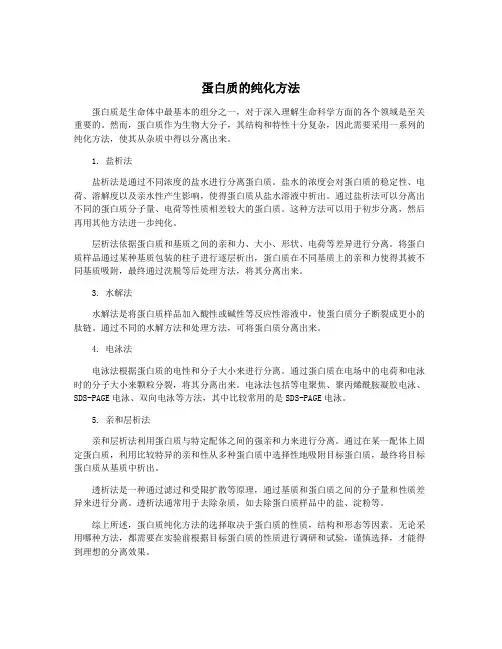
蛋白质的纯化方法蛋白质是生命体中最基本的组分之一,对于深入理解生命科学方面的各个领域是至关重要的。
然而,蛋白质作为生物大分子,其结构和特性十分复杂,因此需要采用一系列的纯化方法,使其从杂质中得以分离出来。
1. 盐析法盐析法是通过不同浓度的盐水进行分离蛋白质。
盐水的浓度会对蛋白质的稳定性、电荷、溶解度以及亲水性产生影响,使得蛋白质从盐水溶液中析出。
通过盐析法可以分离出不同的蛋白质分子量、电荷等性质相差较大的蛋白质。
这种方法可以用于初步分离,然后再用其他方法进一步纯化。
层析法依据蛋白质和基质之间的亲和力、大小、形状、电荷等差异进行分离。
将蛋白质样品通过某种基质包装的柱子进行逐层析出,蛋白质在不同基质上的亲和力使得其被不同基质吸附,最终通过洗脱等后处理方法,将其分离出来。
3. 水解法水解法是将蛋白质样品加入酸性或碱性等反应性溶液中,使蛋白质分子断裂成更小的肽链。
通过不同的水解方法和处理方法,可将蛋白质分离出来。
4. 电泳法电泳法根据蛋白质的电性和分子大小来进行分离。
通过蛋白质在电场中的电荷和电泳时的分子大小来颗粒分裂,将其分离出来。
电泳法包括等电聚焦、聚丙烯酰胺凝胶电泳、SDS-PAGE电泳、双向电泳等方法,其中比较常用的是SDS-PAGE电泳。
5. 亲和层析法亲和层析法利用蛋白质与特定配体之间的强亲和力来进行分离。
通过在某一配体上固定蛋白质,利用比较特异的亲和性从多种蛋白质中选择性地吸附目标蛋白质,最终将目标蛋白质从基质中析出。
透析法是一种通过滤过和受限扩散等原理,通过基质和蛋白质之间的分子量和性质差异来进行分离。
透析法通常用于去除杂质,如去除蛋白质样品中的盐、淀粉等。
综上所述,蛋白质纯化方法的选择取决于蛋白质的性质,结构和形态等因素。
无论采用哪种方法,都需要在实验前根据目标蛋白质的性质进行调研和试验,谨慎选择,才能得到理想的分离效果。
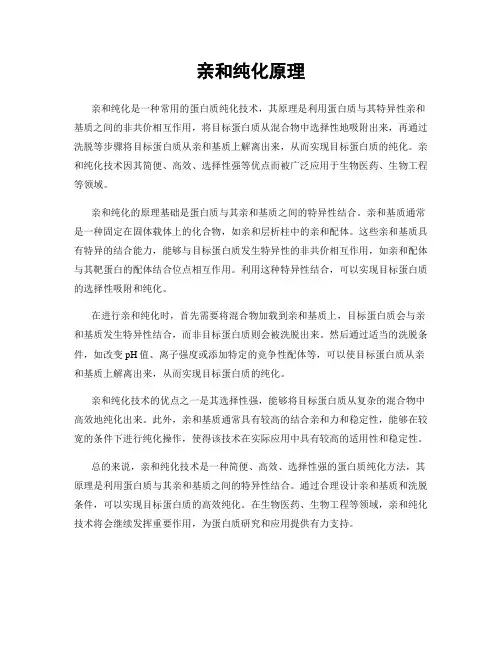
亲和纯化原理
亲和纯化是一种常用的蛋白质纯化技术,其原理是利用蛋白质与其特异性亲和基质之间的非共价相互作用,将目标蛋白质从混合物中选择性地吸附出来,再通过洗脱等步骤将目标蛋白质从亲和基质上解离出来,从而实现目标蛋白质的纯化。
亲和纯化技术因其简便、高效、选择性强等优点而被广泛应用于生物医药、生物工程等领域。
亲和纯化的原理基础是蛋白质与其亲和基质之间的特异性结合。
亲和基质通常是一种固定在固体载体上的化合物,如亲和层析柱中的亲和配体。
这些亲和基质具有特异的结合能力,能够与目标蛋白质发生特异性的非共价相互作用,如亲和配体与其靶蛋白的配体结合位点相互作用。
利用这种特异性结合,可以实现目标蛋白质的选择性吸附和纯化。
在进行亲和纯化时,首先需要将混合物加载到亲和基质上,目标蛋白质会与亲和基质发生特异性结合,而非目标蛋白质则会被洗脱出来。
然后通过适当的洗脱条件,如改变pH值、离子强度或添加特定的竞争性配体等,可以使目标蛋白质从亲和基质上解离出来,从而实现目标蛋白质的纯化。
亲和纯化技术的优点之一是其选择性强,能够将目标蛋白质从复杂的混合物中高效地纯化出来。
此外,亲和基质通常具有较高的结合亲和力和稳定性,能够在较宽的条件下进行纯化操作,使得该技术在实际应用中具有较高的适用性和稳定性。
总的来说,亲和纯化技术是一种简便、高效、选择性强的蛋白质纯化方法,其原理是利用蛋白质与其亲和基质之间的特异性结合。
通过合理设计亲和基质和洗脱条件,可以实现目标蛋白质的高效纯化。
在生物医药、生物工程等领域,亲和纯化技术将会继续发挥重要作用,为蛋白质研究和应用提供有力支持。
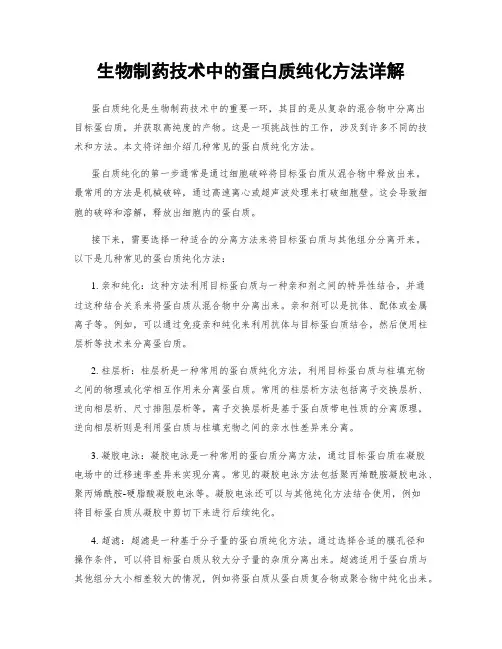
生物制药技术中的蛋白质纯化方法详解蛋白质纯化是生物制药技术中的重要一环,其目的是从复杂的混合物中分离出目标蛋白质,并获取高纯度的产物。
这是一项挑战性的工作,涉及到许多不同的技术和方法。
本文将详细介绍几种常见的蛋白质纯化方法。
蛋白质纯化的第一步通常是通过细胞破碎将目标蛋白质从混合物中释放出来。
最常用的方法是机械破碎,通过高速离心或超声波处理来打破细胞壁。
这会导致细胞的破碎和溶解,释放出细胞内的蛋白质。
接下来,需要选择一种适合的分离方法来将目标蛋白质与其他组分分离开来。
以下是几种常见的蛋白质纯化方法:1. 亲和纯化:这种方法利用目标蛋白质与一种亲和剂之间的特异性结合,并通过这种结合关系来将蛋白质从混合物中分离出来。
亲和剂可以是抗体、配体或金属离子等。
例如,可以通过免疫亲和纯化来利用抗体与目标蛋白质结合,然后使用柱层析等技术来分离蛋白质。
2. 柱层析:柱层析是一种常用的蛋白质纯化方法,利用目标蛋白质与柱填充物之间的物理或化学相互作用来分离蛋白质。
常用的柱层析方法包括离子交换层析、逆向相层析、尺寸排阻层析等。
离子交换层析是基于蛋白质带电性质的分离原理,逆向相层析则是利用蛋白质与柱填充物之间的亲水性差异来分离。
3. 凝胶电泳:凝胶电泳是一种常用的蛋白质分离方法,通过目标蛋白质在凝胶电场中的迁移速率差异来实现分离。
常见的凝胶电泳方法包括聚丙烯酰胺凝胶电泳、聚丙烯酰胺-硬脂酸凝胶电泳等。
凝胶电泳还可以与其他纯化方法结合使用,例如将目标蛋白质从凝胶中剪切下来进行后续纯化。
4. 超滤:超滤是一种基于分子量的蛋白质纯化方法。
通过选择合适的膜孔径和操作条件,可以将目标蛋白质从较大分子量的杂质分离出来。
超滤适用于蛋白质与其他组分大小相差较大的情况,例如将蛋白质从蛋白质复合物或聚合物中纯化出来。
5. 透析:透析是一种常用的蛋白质纯化和浓缩方法,通过将混合物置于透析膜中,根据蛋白质与其他组分之间的分子量差异来实现分离。
透析可以用于去除小分子杂质、盐溶液等,从而获得高纯度的蛋白质。
分离纯化蛋白质的方法及原理
蛋白质纯化是生物分子的一项重要技术,它是分子生物学的核心技术之一,也是蛋白质结构及功能的研究的基础。
它可以从生物样本中分离出蛋白质,研究其结构、性质、功能及相关特性。
根据蛋白质纯化的原理和方法,可以分为物理法、化学法和生物学法等。
1.物理法
物理法是纯化蛋白的最简单方法之一,通常通过使用力场或温度去把一定浓度的蛋白质从溶质中萃取出来。
物理法不耗费能量也不会改变蛋白质的化学结构,不改变蛋白质的结构和功能,但有时可能会引发蛋白质的活性降低,因为櫛发性和相互之间复合物的结合可能会受到改变。
例如分子筛膜技术、沉淀离心技术等。
2.化学法
化学法是一种可以改变蛋白质结构的方法,一般是通过有机溶剂或水溶性固定相,以水或有机溶剂和化学试剂实现蛋白质的分离和纯化。
化学法可以破坏蛋白质的活性,从而改变其化学结构和功能,或者通过改变蛋白质的电性或物理状态来实现蛋白质的分离和纯化。
例如偏光技术、电泳技术、蛋白质酶剪切技术等。
3.生物学法
生物学法是一种比较复杂的蛋白质分离方法,是利用特定生物因子。
四种蛋白纯化的有效方法四种蛋白纯化的有效方法在进行蛋白质研究和酶工程等领域的实验过程中,常常需要将目标蛋白从复杂的混合物中纯化出来。
蛋白纯化的目的是获取高纯度的目标蛋白样品,以便进一步进行结构和功能研究。
然而,由于蛋白质的复杂性以及其在混合物中的低浓度,蛋白纯化常常面临一系列的挑战。
为了克服这些挑战,科学家们开发了多种蛋白纯化的方法。
在本文中,我们将介绍四种常见而高效的蛋白纯化方法,并探讨其原理和适用性。
1. 亲和层析法:亲和层析法是一种利用目标蛋白与配体之间的特异性结合进行纯化的方法。
这种方法基于目标蛋白与配体之间的亲和力,通过设计具有高亲和性的配体来选择性地结合目标蛋白。
在实验中,我们可以将配体固定于固相材料上,例如琼脂糖或石蜡烃树脂,并将载有目标蛋白的混合物与这些固定化的亲和基质进行接触。
随后,非特异性蛋白质被洗脱,而目标蛋白则被保留下来。
目标蛋白可以通过改变条件(例如改变pH值或添加竞争性配体)来洗脱。
亲和层析法的优点在于具有高选择性和高纯度的优势。
然而,由于亲和剂的设计和合成需要具有相关专业知识,并且选择适当的配体是关键。
亲和层析法在不同的纯化过程中的适用性会有所不同。
2. 凝胶过滤层析法(Gel Filtration Chromatography):凝胶过滤层析法是通过分子量的差异将混合物中的蛋白质分离的一种方法。
凝胶过滤层析法是利用凝胶材料,例如琼脂糖或琼脂糖-聚丙烯酰胺凝胶,通过分子在凝胶孔隙中的渗透性而将蛋白分离开来。
较大的蛋白分子无法进入凝胶孔隙,因此会在凝胶的表面留下。
较小的蛋白分子则能够渗透进入凝胶孔隙中,因此会相对于较大的蛋白分子更早地溢出。
凝胶过滤层析法的优点在于操作简单、速度快,且可以对蛋白进行某种程度的分离。
然而,该方法的分离效果受到蛋白质在凝胶中的体积效应的限制,因此对于体积较大的蛋白分子,凝胶过滤层析可能无法实现理想的分离效果。
3. 离子交换层析法:离子交换层析法是一种基于蛋白与离子交换材料之间的电荷相互作用进行纯化的方法。
请举四种蛋白质类制品分离纯化方法,并说明一下其原理
以下是四种蛋白质类制品分离纯化方法及其原理的举例:
1. 盐析法:盐析法是利用蛋白质在不同盐浓度下溶解度的差异进行分离纯化。
具体来说,在蛋白质溶液中添加适量中性盐,使得蛋白质的溶解度降低并析出,从而达到分离纯化的目的。
这种方法的原理是蛋白质与盐离子形成复合物,且复合物的溶解度较低,因此在盐浓度较高时,蛋白质会沉淀出来。
2. 等电点沉淀法:等电点沉淀法是利用蛋白质在不同 pH 值下的等电点进行分离纯化。
具体来说,将蛋白质溶液调节至其等电点 pH 值,使得蛋白质失去电荷,形成稳定的沉淀,从而达到分离纯化的目的。
这种方法的原理是蛋白质在不同 pH 值下带电荷的数量不同,因此在等电点时,蛋白质会沉淀出来。
3. 低温有机溶剂沉淀法:低温有机溶剂沉淀法是利用蛋白质在低温下溶解度的差异进行分离纯化。
具体来说,将蛋白质溶液引入与水可混溶的有机溶剂中,使得蛋白质的溶解度降低并析出,从而达到分离纯化的目的。
这种方法的原理是蛋白质在水中的溶解度受温度和溶剂性质的影响,而在有机溶剂中,蛋白质的溶解度较低,因此可以分离纯化。
4. 亲和色谱法:亲和色谱法是利用蛋白质与配体之间的特异性结合进行分离纯化。
具体来说,利用具有特异性结合能力的载体,将待分离的蛋白质与载体结合,然后通过改变洗脱液 pH 值或离子强度等方法,将结合在载体上的蛋白质洗脱出来。
这种方法的原理是蛋白
质与配体之间的相互作用可以影响蛋白质的溶解度、电离性质等,从而进行分离纯化。
蛋白质纯化方法及原理
蛋白质纯化是一种技术,它将一种特定的蛋白质从其他物质中分离出来,使其达到一定的纯度。
蛋白质纯化的技术有很多种,它们的原理也有所不同。
其中,最常用的纯化技术是电泳分离技术,它可以利用电场的力将蛋白质和其他物质分开,从而实现蛋白质的纯化。
电泳分离技术的原理是,在电场作用下,蛋白质和其他物质形成质子流,由于质子流的原因,蛋白质会在电场中运动,而其他物质则会沿着电场而不动。
由于蛋白质和其他物质的不同性质,电场的作用使它们在电泳液中分开,从而达到纯化蛋白质的目的。
另外,蛋白质纯化也可以利用离子交换技术来实现。
离子交换技术是利用离子交换柱上的离子交换树脂,将蛋白质与其他物质分离的技术。
当蛋白质溶液通过离子交换柱时,蛋白质会被离子交换树脂吸附,而其他物质不会被吸附,从而实现蛋白质的纯化。
此外,蛋白质纯化也可以采用硅胶凝胶柱技术来实现。
硅胶凝胶柱技术是通过利用蛋白质与硅胶凝胶之间的相互作用,将蛋白质与其他物质分离的技术。
当蛋白质溶液通过硅胶凝胶柱时,蛋白质会被硅胶凝胶柱吸附,而其他物质不会被吸附,从而实现蛋白质的纯化。
蛋白质纯化的技术有很多,上述介绍的只是其中三种最常用的技术,
其原理也不尽相同。
不同的技术需要不同的条件,但它们都是通过利用蛋白质与其他物质之间的性质差异,来实现蛋白质的纯化。
蛋白质分离纯化主要方法
一、抽提
1、抽提冷冻干燥法
抽提冷冻干燥法是抽提当中常用的一种方法,能将活性蛋白以及未发生水解的蛋白从膜结构层中抽提出来,这种方法是一种简单、快捷、方便的抽提方法,可以较为有效的分离纯化未发生水解的蛋白,其原理是,将膜结构或者蛋白质复合物冷冻干燥,冷冻干燥后的蛋白质复合物会在温度迅速升高的情况下发生水解,蛋白质以抽提的形式分离出来,进而得到纯的蛋白质。
2、抽提凝胶凝集法
抽提凝胶凝集法是将蛋白质和抗体通过凝胶结合产生凝集反应,分离纯化蛋白质的一种方法。
这种方法可以将蛋白质从活性溶液和抗性溶液中分离出来,凝胶凝集反应主要是利用结合反应,将蛋白质物质结合到凝胶表面上,然后用浓盐溶液洗去不结合的物质。
矿产资源开发利用方案编写内容要求及审查大纲
矿产资源开发利用方案编写内容要求及《矿产资源开发利用方案》审查大纲一、概述
㈠矿区位置、隶属关系和企业性质。
如为改扩建矿山, 应说明矿山现状、
特点及存在的主要问题。
㈡编制依据
(1简述项目前期工作进展情况及与有关方面对项目的意向性协议情况。
(2 列出开发利用方案编制所依据的主要基础性资料的名称。
如经储量管理部门认定的矿区地质勘探报告、选矿试验报告、加工利用试验报告、工程地质初评资料、矿区水文资料和供水资料等。
对改、扩建矿山应有生产实际资料, 如矿山总平面现状图、矿床开拓系统图、采场现状图和主要采选设备清单等。
二、矿产品需求现状和预测
㈠该矿产在国内需求情况和市场供应情况
1、矿产品现状及加工利用趋向。
2、国内近、远期的需求量及主要销向预测。
㈡产品价格分析
1、国内矿产品价格现状。
2、矿产品价格稳定性及变化趋势。
三、矿产资源概况
㈠矿区总体概况
1、矿区总体规划情况。
2、矿区矿产资源概况。
3、该设计与矿区总体开发的关系。
㈡该设计项目的资源概况
1、矿床地质及构造特征。
2、矿床开采技术条件及水文地质条件。